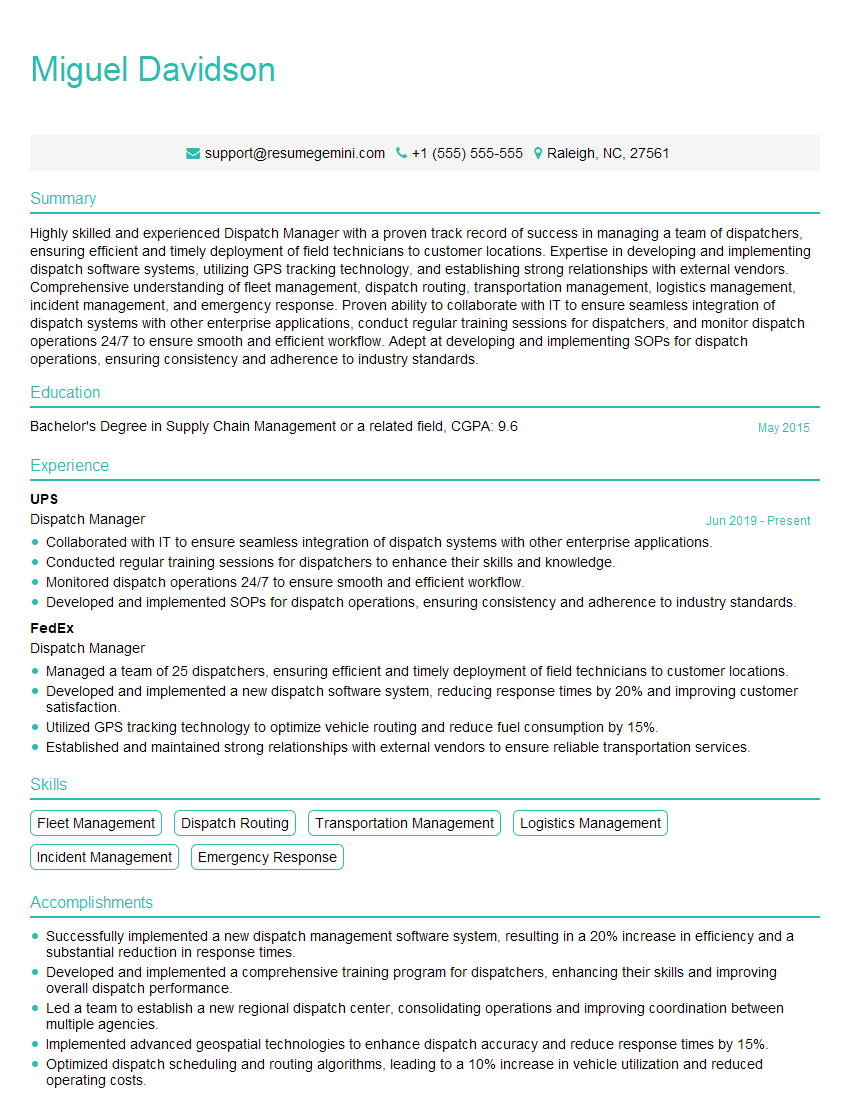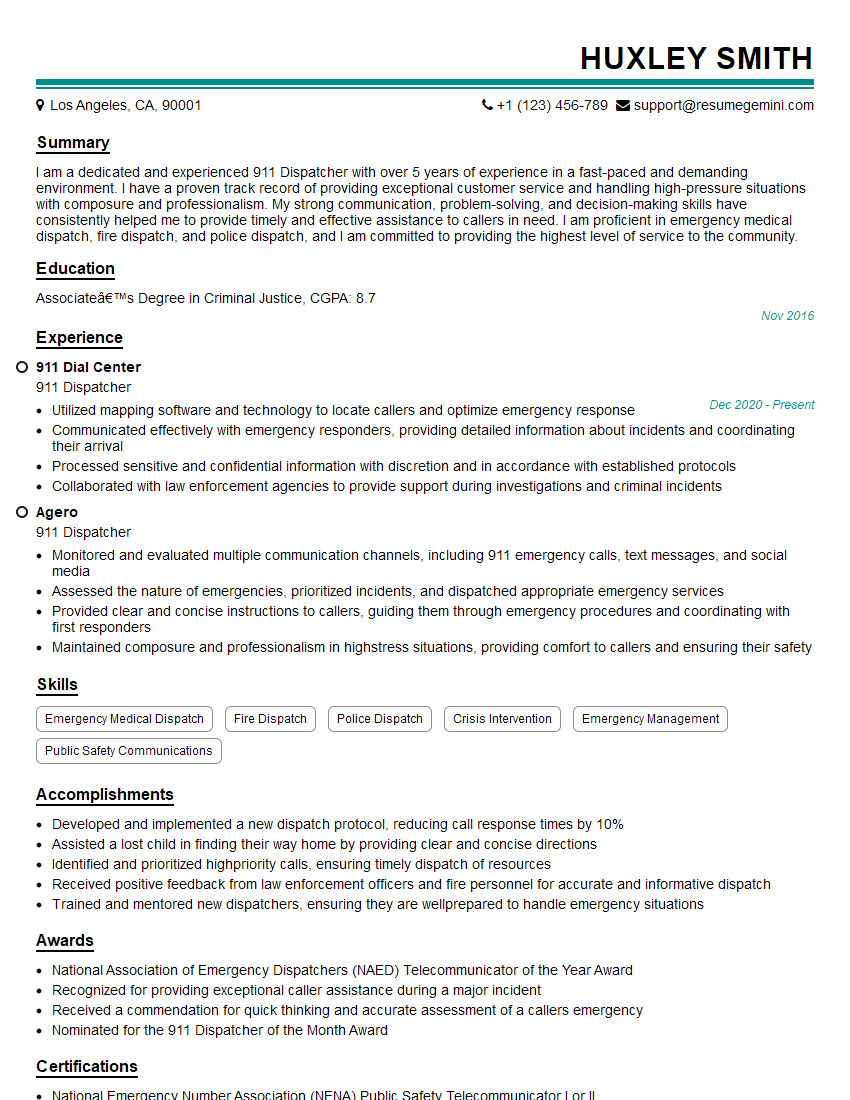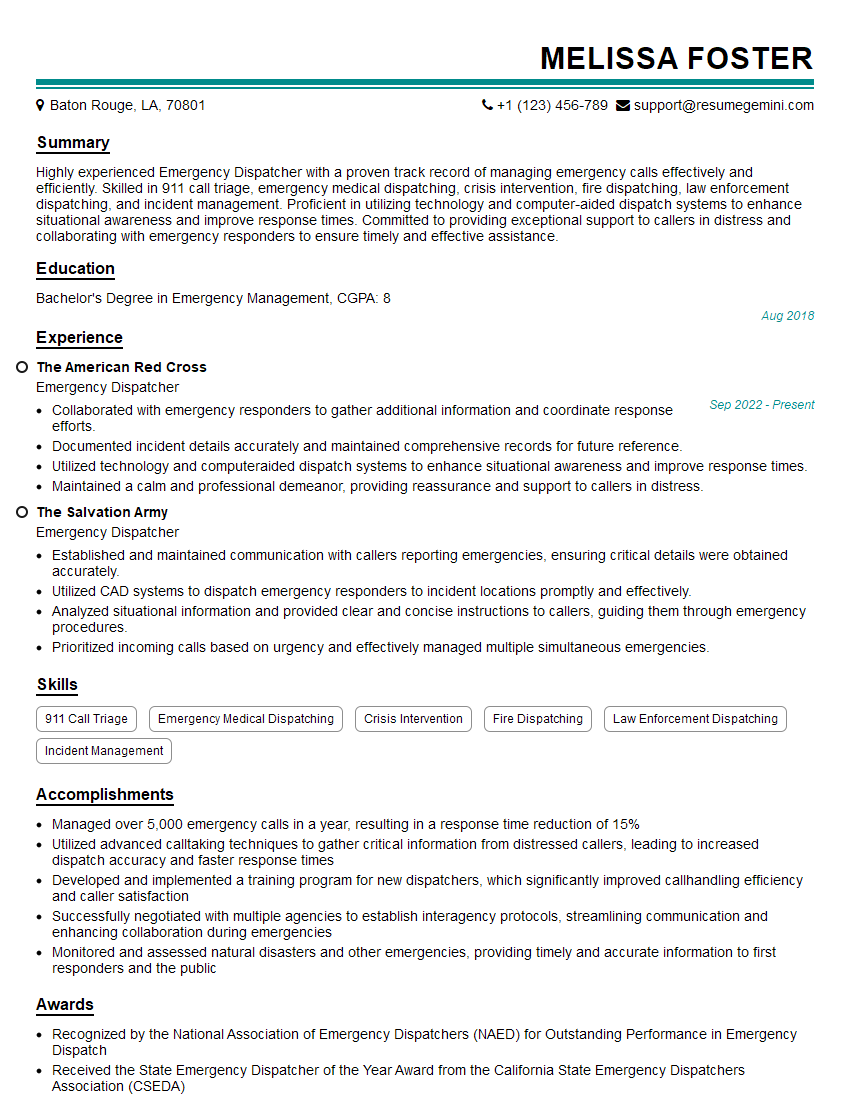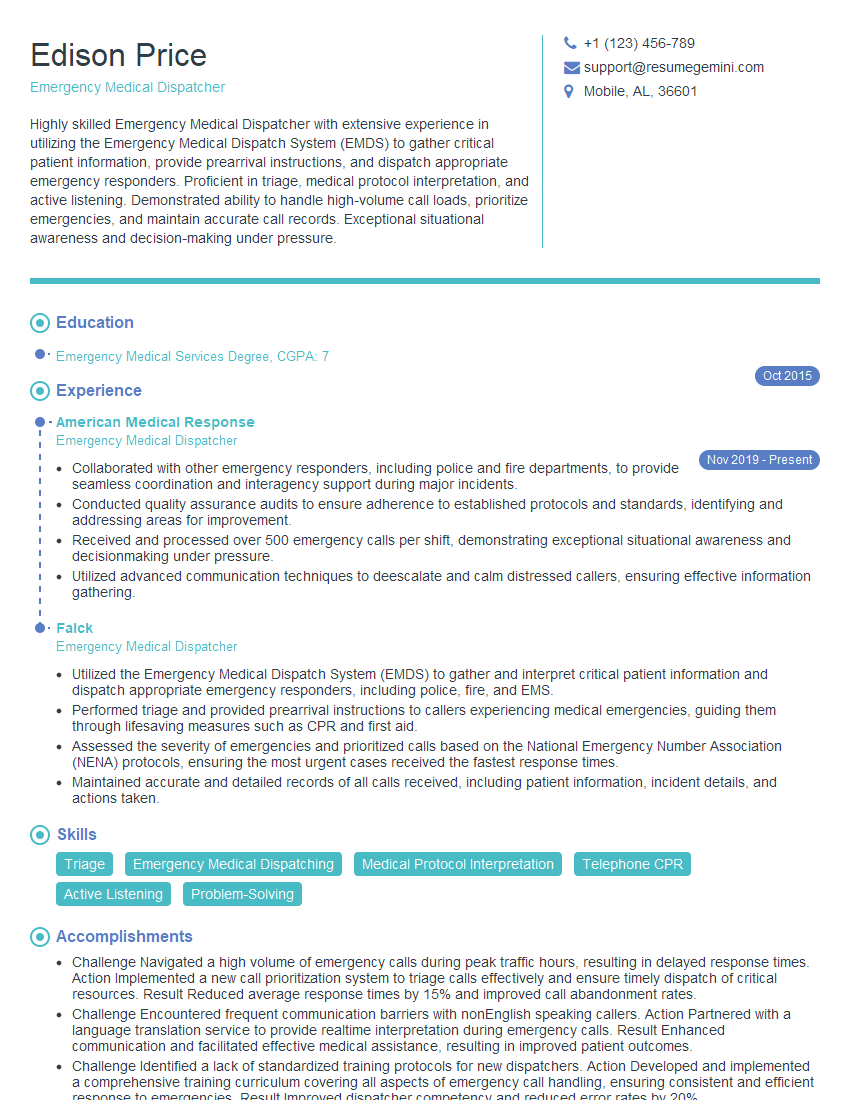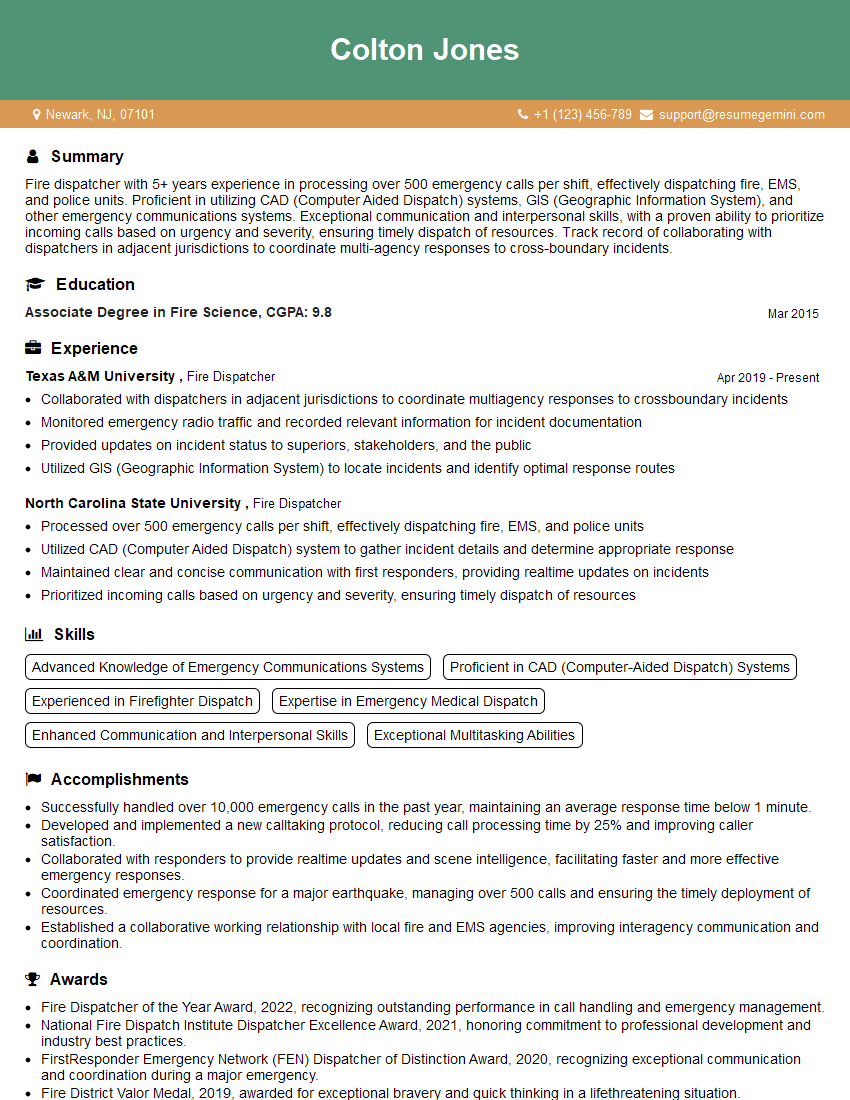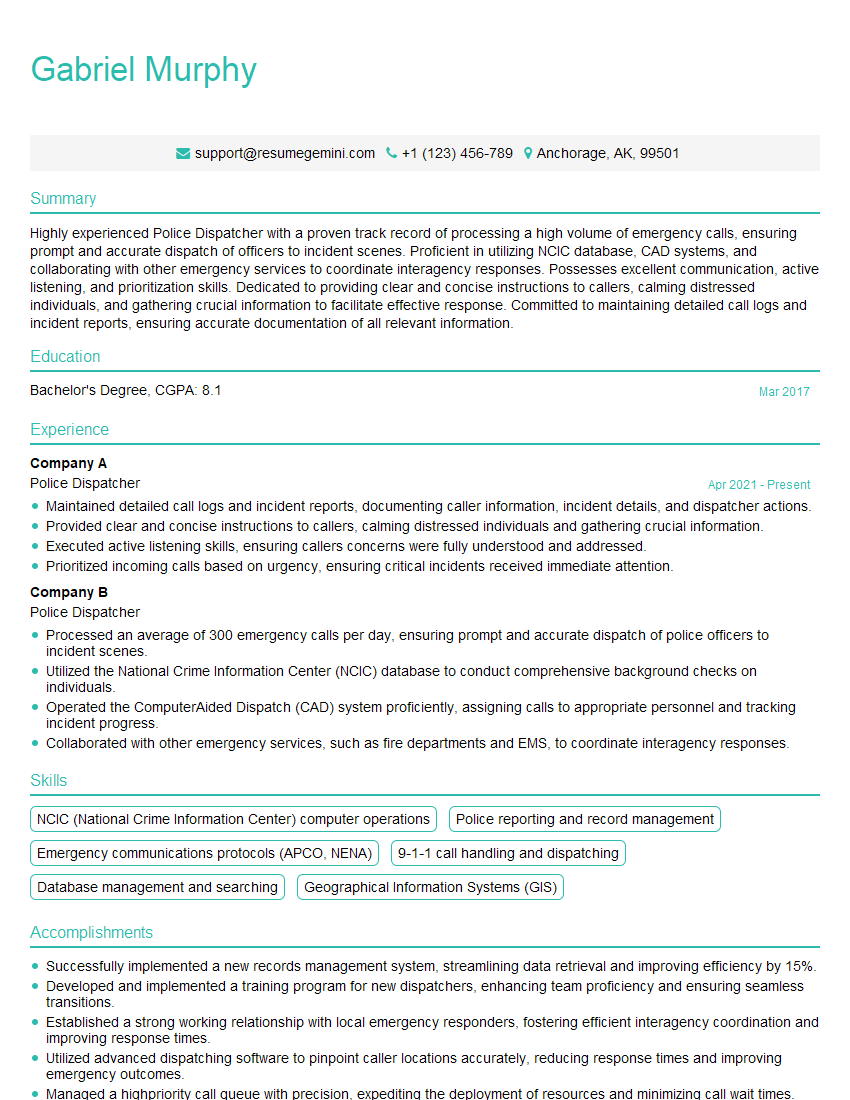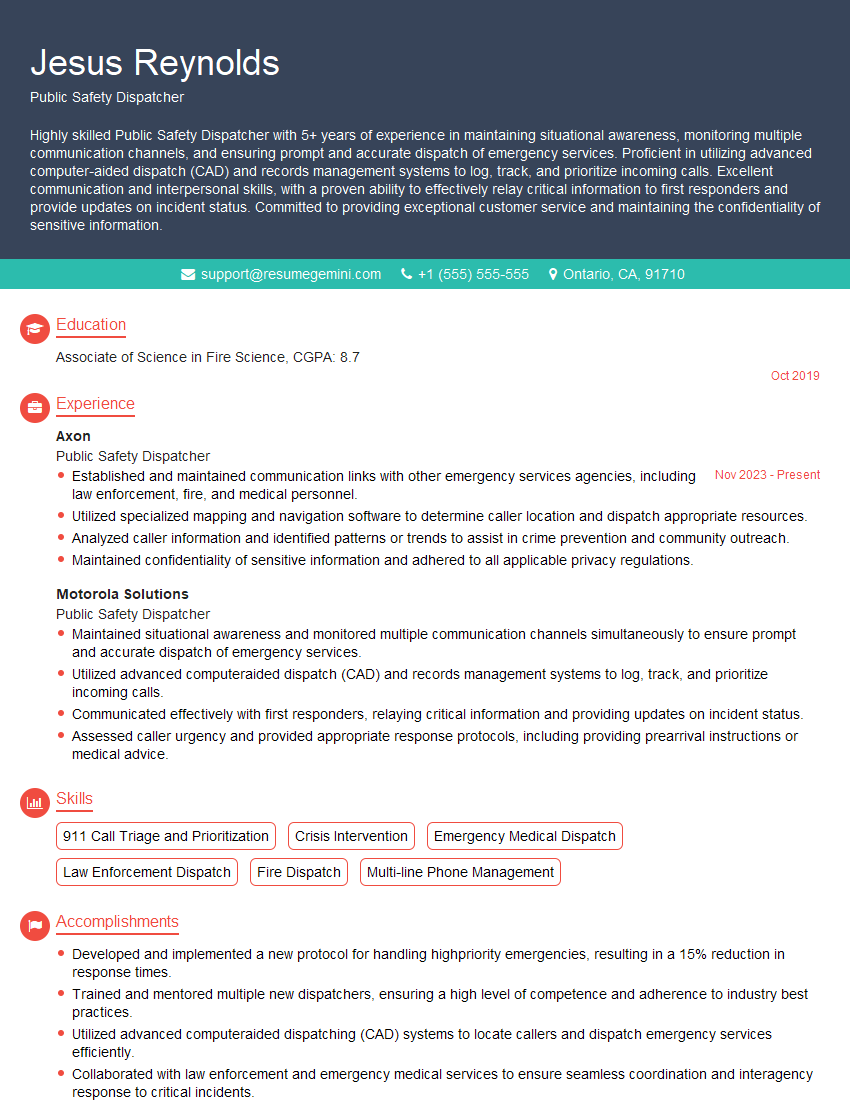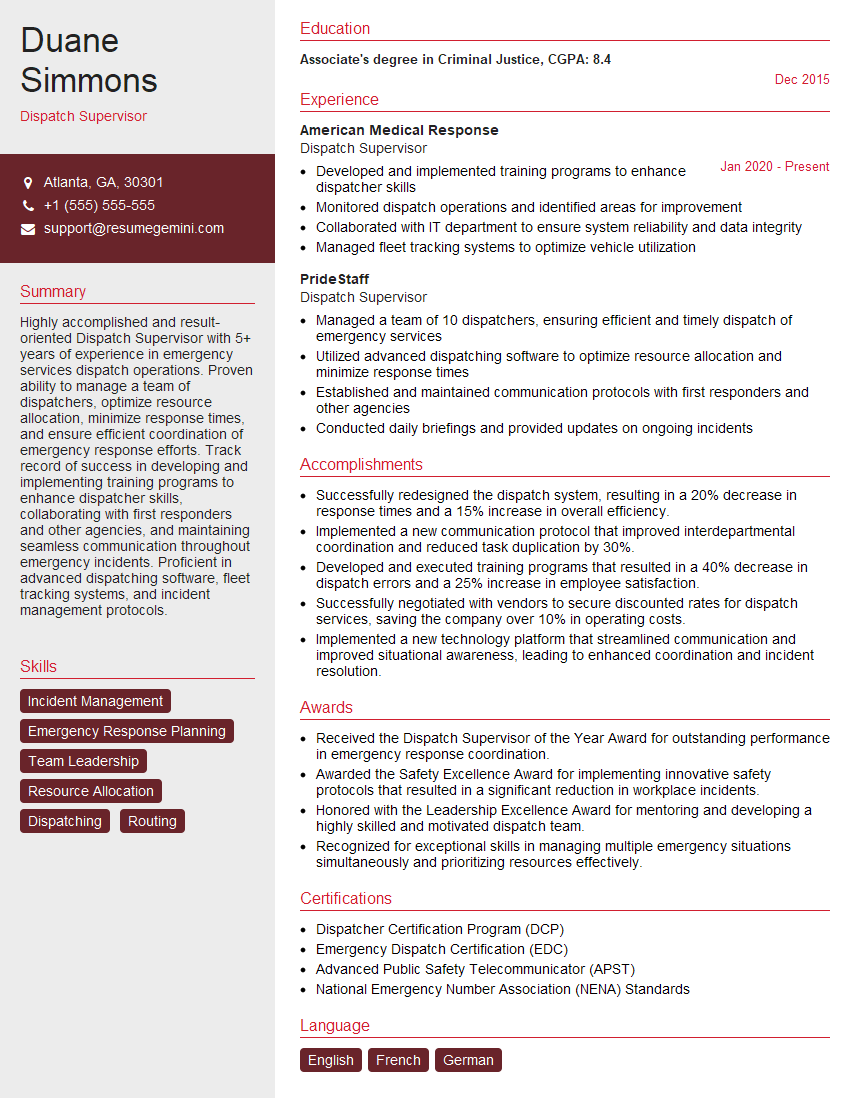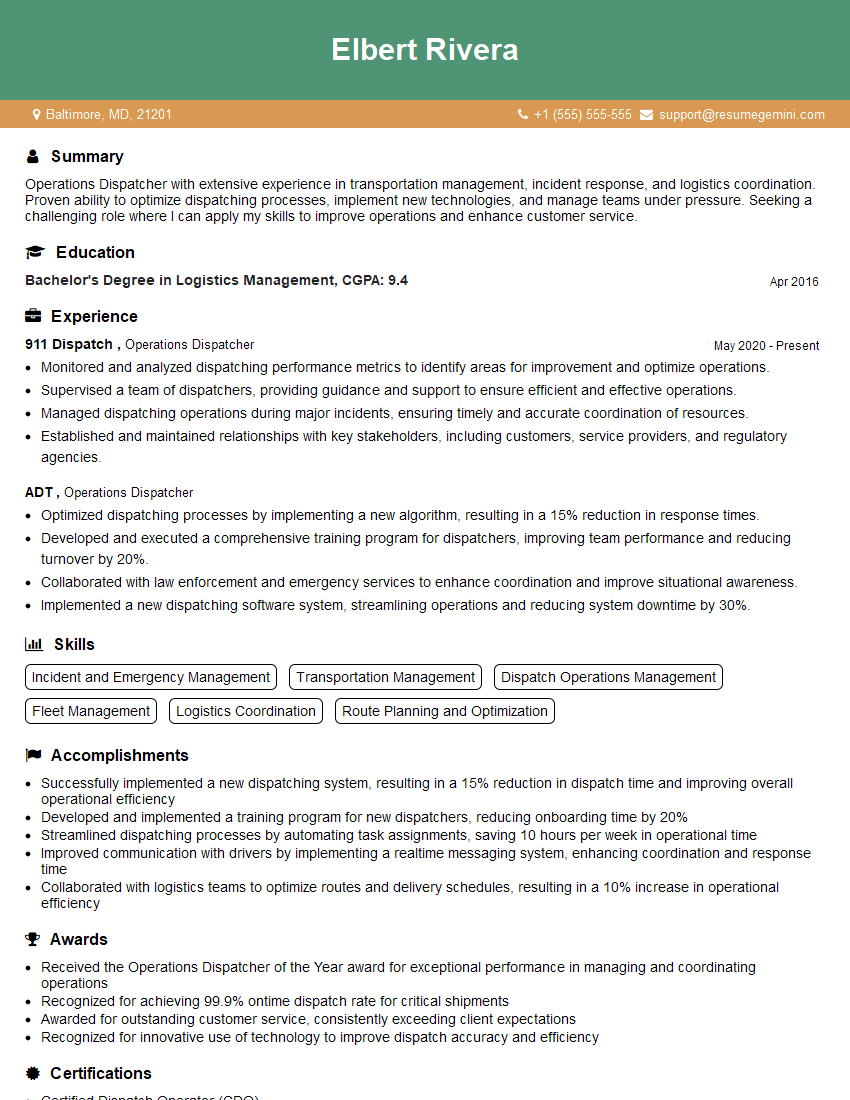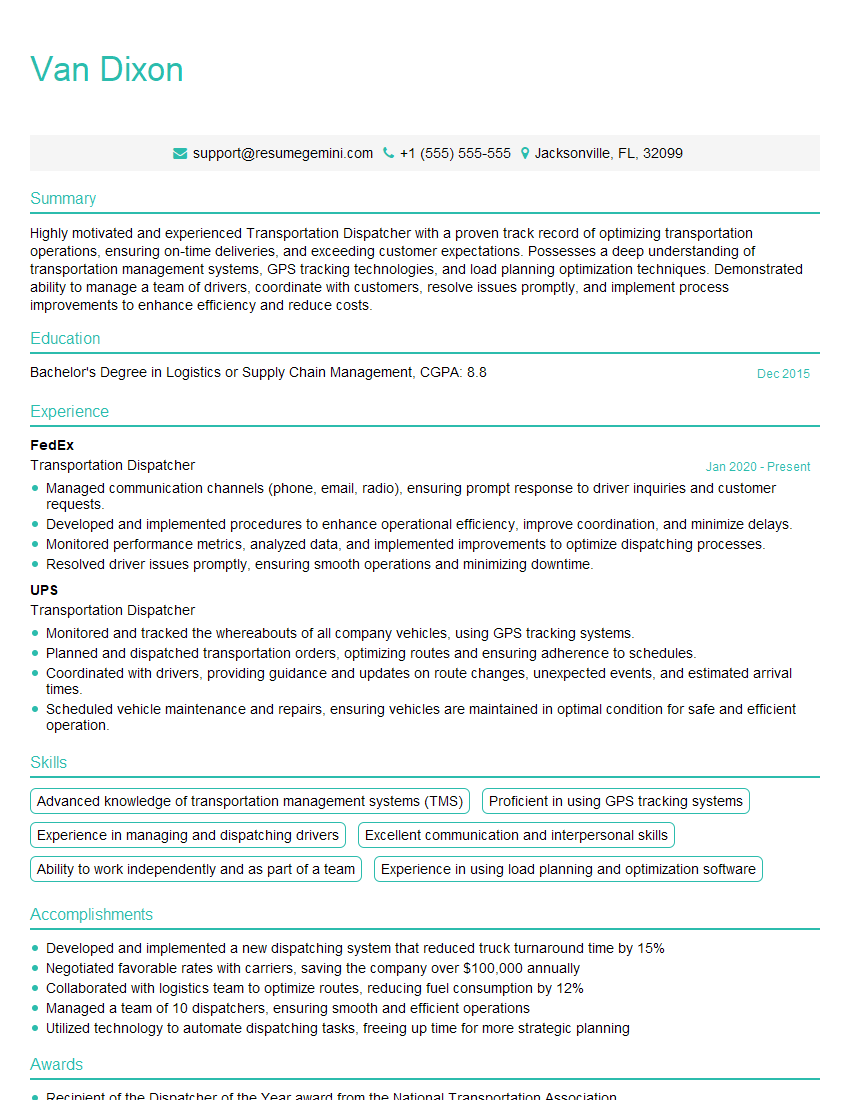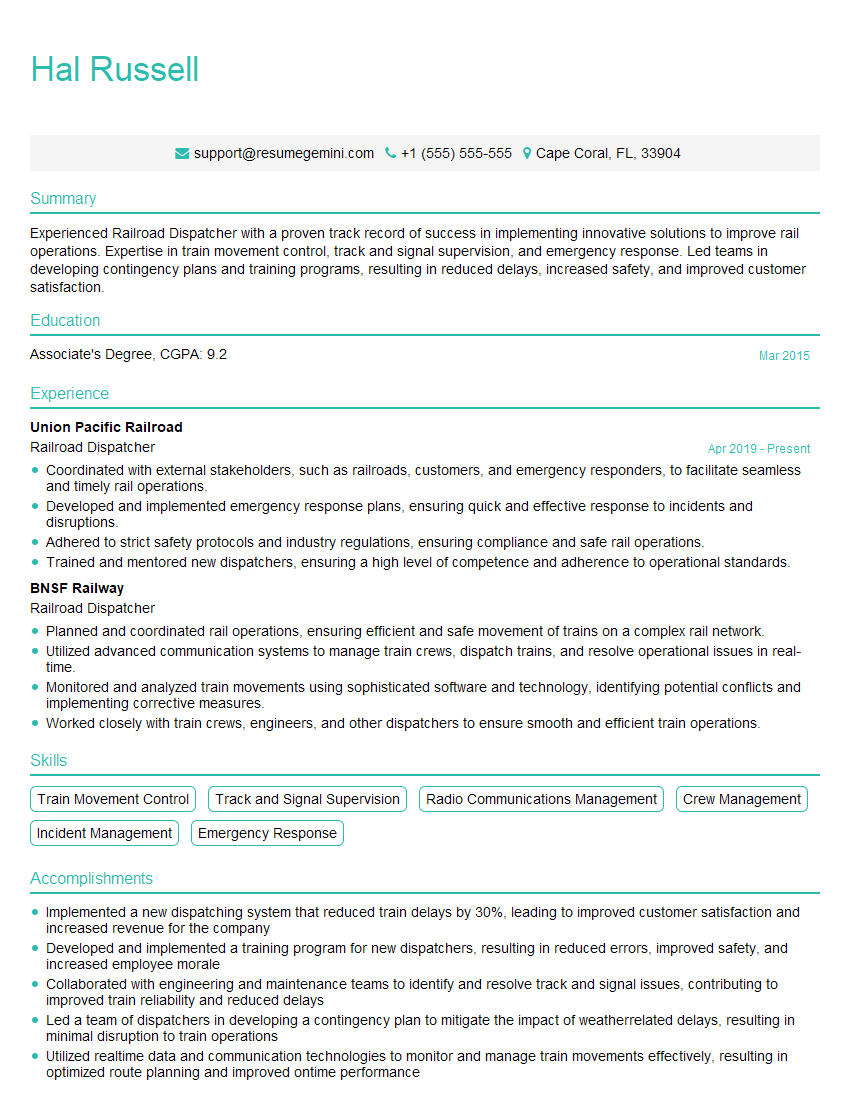Unlock your full potential by mastering the most common Dispatching Operations interview questions. This blog offers a deep dive into the critical topics, ensuring you’re not only prepared to answer but to excel. With these insights, you’ll approach your interview with clarity and confidence.
Questions Asked in Dispatching Operations Interview
Q 1. Describe your experience with route optimization software.
Route optimization software is crucial for maximizing efficiency in dispatching operations. I have extensive experience using various platforms, including both proprietary and cloud-based solutions. These systems leverage algorithms to analyze factors like distance, traffic patterns, delivery windows, and driver availability to generate the most efficient routes. For instance, in my previous role, we implemented a system that reduced our delivery times by 15% by dynamically adjusting routes based on real-time traffic data. This meant fewer delays and happier customers. My experience includes not just using the software but also configuring it to meet specific needs, integrating it with other systems like GPS tracking and order management, and training dispatchers on its effective use. I’m proficient in understanding the different algorithms employed (e.g., nearest neighbor, Clarke & Wright) and can assess the strengths and weaknesses of various solutions to select the best fit for a given operation.
For example, one system I worked with used a sophisticated algorithm incorporating real-time traffic data feeds from city transportation departments, allowing us to reroute vehicles around accidents or unexpected congestion. Another system allowed us to optimize routes considering vehicle capacities and delivery deadlines, ensuring we could efficiently handle diverse product types and delivery windows.
Q 2. How do you handle multiple urgent requests simultaneously?
Handling multiple urgent requests simultaneously requires a calm, systematic approach and strong prioritization skills. I utilize a combination of techniques, including:
- Prioritization Matrix: I categorize urgent requests based on factors like the severity of the situation (e.g., medical emergency vs. late delivery), the impact on the client, and the available resources. This matrix allows me to quickly identify which requests demand immediate attention.
- Communication & Coordination: Clear and concise communication with drivers, clients, and other dispatchers is crucial. I use standardized communication protocols to ensure everyone is informed and coordinated. This may include using dispatch software with integrated messaging or dedicated communication channels.
- Resource Allocation: I assess the availability of drivers, vehicles, and other resources to assign tasks effectively. This might involve temporarily reassigning drivers or utilizing available backup resources.
- Escalation Protocol: For requests exceeding my capacity or requiring specialized handling, I have a clear protocol for escalating the issue to supervisors or other relevant personnel.
Imagine a scenario where we receive multiple requests simultaneously – one is a medical emergency, another is a high-value time-sensitive shipment, and the third is a routine delivery. Using my prioritization matrix, I’d immediately address the medical emergency, then the high-value shipment, and finally the routine delivery, allocating resources and communicating status updates to all involved parties.
Q 3. Explain your process for tracking vehicle location and status.
Tracking vehicle location and status is fundamental to efficient dispatching. I rely on GPS tracking systems integrated with our dispatch software. These systems provide real-time data on vehicle location, speed, direction, and other relevant information. This data is displayed on a central dashboard, allowing me to monitor the progress of all vehicles simultaneously. The system also often includes features such as:
- Geofencing: Setting virtual boundaries to trigger alerts if a vehicle enters or exits a designated area.
- ETA calculations: Providing accurate estimated times of arrival based on real-time traffic and vehicle speed.
- Idle time monitoring: Identifying periods of inactivity to address potential issues or inefficiencies.
- Automated reporting: Generating reports on vehicle performance, mileage, and other key metrics.
For example, if a vehicle is delayed, the system might provide information about the cause – traffic congestion, mechanical problems, etc. – helping me to take timely corrective action and inform the client.
Q 4. What metrics do you use to measure dispatch efficiency?
Measuring dispatch efficiency relies on a variety of key performance indicators (KPIs). The metrics I routinely track include:
- On-time delivery rate: The percentage of deliveries completed on schedule.
- Average delivery time: The average time taken to complete a delivery.
- Vehicle utilization rate: The percentage of time vehicles are actively engaged in deliveries.
- Fuel efficiency: Monitoring fuel consumption per delivery or per mile to identify areas for improvement.
- Driver productivity: Number of deliveries completed per driver per day or other relevant time frame.
- Customer satisfaction: Tracking client feedback to assess the overall effectiveness of the dispatching process.
By tracking these metrics, I can identify bottlenecks, areas of inefficiency, and opportunities for improvement. This data-driven approach ensures continuous optimization of our dispatching operations.
Q 5. How do you prioritize tasks during peak demand?
Prioritizing tasks during peak demand requires a well-defined strategy. My approach combines several methods:
- Time-sensitive tasks first: Requests with strict deadlines or critical time constraints are handled with priority.
- High-value clients first: Clients with high-value contracts or strategic importance receive preferential treatment.
- Geographic clustering: Grouping deliveries in close proximity to optimize routes and minimize travel time.
- Load balancing: Ensuring a fair distribution of workload across drivers, to prevent burnout and ensure consistent service levels.
- Dynamic adjustments: Regularly reassessing priorities and making real-time adjustments based on changing conditions.
Imagine a scenario where there are more orders than drivers during a holiday rush. My approach ensures high-value clients still get their deliveries within their expected timeframes, while other requests are handled efficiently to minimize customer delays as much as possible. Clear communication with customers about potential delays is critical.
Q 6. Describe your experience with GPS tracking systems.
My experience with GPS tracking systems spans various technologies and implementations. I’m familiar with both hardware and software components, including satellite communication protocols, data transmission methods, and data processing systems. I’ve worked with both in-vehicle GPS units and smartphone-based tracking solutions. My expertise extends beyond simply using the systems; it includes integrating them with other software applications, managing data accuracy, and troubleshooting technical issues. For example, I’ve helped identify and resolve discrepancies between GPS data and actual vehicle location, leading to improved accuracy and decision-making within the dispatching team.
In one instance, we successfully transitioned from a legacy GPS system to a newer, more advanced cloud-based platform. This improved the accuracy and reliability of location data, allowing for more efficient route optimization and real-time monitoring of vehicle status. The new system also allowed for better integration with our dispatch software, providing a more streamlined workflow.
Q 7. How do you handle driver delays or unexpected events?
Handling driver delays or unexpected events requires proactive communication and problem-solving. My approach involves:
- Immediate communication: Contacting the driver to understand the cause of the delay and assess the situation.
- Problem identification and solution: Identifying the root cause of the delay (traffic, accident, mechanical issue, etc.) and determining the best course of action. This might involve rerouting the vehicle, finding a replacement driver, or contacting the client to inform them about the delay.
- Client communication: Keeping the client informed about the delay and providing realistic ETAs. Transparency and proactive communication are key to maintaining customer satisfaction.
- Documentation: Maintaining a detailed record of the incident, including the cause, actions taken, and any relevant communication with drivers and clients.
- Preventative measures: Reviewing the incident to identify any patterns or potential preventative measures to reduce the likelihood of similar delays in the future.
For example, if a driver encounters unexpected traffic, I would use the GPS system to reroute them and inform the client of the revised ETA. If the delay is due to a mechanical issue, I’d arrange for roadside assistance and possibly re-assign the delivery to another driver if necessary.
Q 8. What communication methods do you utilize in dispatch?
Effective communication is the backbone of efficient dispatching. I utilize a multi-faceted approach, tailoring my communication method to the situation and the recipient. This often involves a blend of several tools.
- Two-way radios: These are crucial for real-time updates, especially during urgent situations like traffic incidents or unexpected delays. For example, I might use a radio to immediately alert a driver to a road closure and suggest an alternative route.
- Dispatch software messaging systems: Most modern dispatch software (like McLeod Software or TMWSuite, which I’ve used extensively) include integrated messaging systems allowing for quick, documented communication with drivers and clients. This is great for sending delivery confirmations, assigning new jobs, or providing less urgent updates.
- Phone calls: For complex issues or sensitive information, a phone call ensures clarity and allows for a more personal touch. For instance, I might call a driver to discuss a particularly challenging delivery requiring special handling.
- Email: This is ideal for formal communication, such as sending detailed delivery schedules or addressing customer inquiries. I always ensure emails are professional and well-documented.
The key is selecting the most appropriate method to ensure timely, accurate, and clear communication.
Q 9. Explain your experience with different dispatching software (mention specific names if applicable).
My experience spans several dispatching software platforms. I’ve worked extensively with McLeod Software, TMWSuite, and DAT Power. Each has its strengths and weaknesses.
- McLeod Software: Known for its robust features and integration capabilities, McLeod is excellent for managing large fleets and complex logistics. I’ve utilized its advanced route optimization tools and reporting features to significantly improve efficiency.
- TMWSuite: A strong competitor, TMWSuite provides comprehensive fleet management capabilities, including GPS tracking, driver performance monitoring, and automated dispatching features. I appreciated its user-friendly interface and powerful reporting capabilities.
- DAT Power: This platform is particularly useful for load board management, helping me find the best loads for our drivers and optimize capacity utilization. It streamlined our process for finding and securing loads, minimizing downtime.
My familiarity with these systems allows me to quickly adapt to new software and efficiently leverage their capabilities to optimize dispatching operations. I’m adept at using the reporting features of each to track key performance indicators and identify areas for improvement.
Q 10. How do you ensure compliance with regulatory requirements?
Compliance is paramount. My approach involves a multi-pronged strategy to ensure adherence to all relevant regulations, including hours-of-service (HOS) rules, safety regulations, and environmental guidelines.
- Electronic Logging Devices (ELDs): I’m proficient in using and managing ELD data to ensure driver compliance with HOS regulations. This includes regularly reviewing driver logs for any potential violations and proactively addressing any issues.
- Driver training and education: I actively participate in training drivers on relevant regulations and best practices. This includes regular briefings on updated rules and safe driving techniques.
- Regular audits and inspections: I conduct regular internal audits to ensure compliance with all applicable regulations. This includes reviewing driver records, maintenance logs, and dispatch records.
- Staying updated on regulatory changes: I continuously monitor changes in regulations to ensure our operations remain compliant. This involves subscribing to industry publications and attending relevant workshops.
A proactive approach to compliance not only ensures legal adherence but also contributes to a safer and more efficient operation.
Q 11. How do you manage driver communication and feedback?
Maintaining open and effective communication with drivers is crucial for success. I utilize various methods to facilitate this:
- Regular check-ins: I regularly communicate with drivers throughout their shifts to address any concerns, provide updates, and offer support. This might involve simple radio check-ins, or more detailed conversations through our dispatch software’s messaging system.
- Feedback mechanisms: I encourage drivers to provide feedback on their experiences. This can be through formal feedback forms, informal conversations, or using dedicated channels within our dispatch software. I treat all feedback seriously, using it to improve operations and address potential issues.
- Performance reviews: I conduct regular performance reviews with drivers, discussing both their strengths and areas for improvement. This helps foster a culture of continuous improvement and open communication.
- Incentive programs: I sometimes participate in the development and implementation of incentive programs that reward safe driving, efficient delivery, and positive customer interactions.
Building a strong driver-dispatcher relationship through open communication is key to improving both safety and efficiency.
Q 12. Describe your problem-solving approach in a high-pressure situation.
In high-pressure situations, my approach emphasizes a systematic and calm response. I follow a structured problem-solving framework:
- Assess the situation: Quickly identify the nature and severity of the problem. What’s causing the issue? What are the potential consequences? For instance, if a driver is stuck in a traffic jam that will cause a late delivery, I need to assess how late it will be and how it affects the customer.
- Prioritize tasks: Determine the most critical tasks and address them first. In the traffic jam example, contacting the customer to provide an update would be a top priority.
- Develop solutions: Brainstorm potential solutions. Perhaps an alternative route is available, or a different driver can be dispatched to assist. In the same example, I could redirect a nearby driver to handle the late delivery.
- Implement the best solution: Select and implement the most effective solution based on available resources and potential consequences.
- Monitor and adjust: Continuously monitor the situation to assess the effectiveness of the implemented solution and make adjustments as needed. This is about making sure the solution is working and adapting if it is not.
Staying calm, focusing on clear communication, and utilizing available resources are critical to effectively managing high-pressure situations.
Q 13. What is your experience with load planning and optimization?
Load planning and optimization are central to my role. I leverage various techniques to ensure efficient utilization of resources and minimize costs.
- Route optimization software: I utilize route optimization software integrated within our dispatch systems (like the ones mentioned earlier) to determine the most efficient routes, considering factors such as distance, traffic, and delivery windows. This significantly reduces fuel consumption and improves delivery times.
- Load consolidation: I consolidate loads whenever possible to maximize vehicle capacity and reduce the number of trips required. This means planning routes where multiple deliveries can be made in a single trip.
- Real-time tracking and adjustments: I use real-time GPS tracking to monitor driver locations and adjust routes as needed to respond to unforeseen events such as traffic delays or unexpected requests.
- Predictive modeling: I use data analytics to predict future demand and proactively plan resources accordingly. This may involve analyzing historical data to forecast delivery volumes and optimizing routes based on these predictions.
Effective load planning and optimization directly impact profitability and efficiency, minimizing costs and maximizing resource utilization.
Q 14. How do you handle customer complaints or inquiries?
Handling customer complaints and inquiries requires a professional and empathetic approach. My process involves:
- Listen actively: Patiently listen to the customer’s complaint or inquiry, ensuring I fully understand their perspective and concerns. Empathy is key here. For example, if a delivery is late, I acknowledge their frustration.
- Apologize sincerely: Offer a sincere apology, even if the issue wasn’t directly our fault. This shows respect and a commitment to resolving the problem.
- Investigate the issue: Thoroughly investigate the issue to determine the root cause and identify solutions. I might check with the driver, review delivery records, or consult with other team members.
- Provide a solution: Offer a concrete solution that addresses the customer’s concerns. This might involve rescheduling a delivery, offering a refund, or providing a detailed explanation of what happened.
- Follow up: Follow up with the customer to ensure their satisfaction and address any remaining concerns. This shows professionalism and ensures customer retention.
By focusing on empathy, prompt action, and effective communication, I aim to transform negative experiences into opportunities to build stronger customer relationships.
Q 15. Describe your understanding of DOT regulations (or other relevant regulations).
My understanding of DOT regulations, specifically focusing on those impacting dispatch operations, is extensive. These regulations, primarily found within Title 49 of the Code of Federal Regulations (CFR), cover crucial aspects like Hours of Service (HOS) for drivers, vehicle maintenance and inspection requirements (including electronic logging devices or ELDs), hazardous materials transportation, and driver qualification. I’m well-versed in the complexities of these rules and how they affect daily dispatch decisions. For example, I meticulously track driver HOS to ensure compliance, preventing violations that could lead to significant fines and operational disruptions. I also ensure that all vehicles undergo regular maintenance and inspections as per DOT regulations, maintaining detailed records of these activities. Understanding the nuances of hazardous materials transportation regulations is critical; I’m adept at ensuring proper documentation and routing for shipments of hazardous goods, prioritizing safety and regulatory compliance.
Beyond DOT, I’m familiar with state-specific regulations that may apply, such as weight limits and permits, and I always prioritize adherence to all applicable laws and regulations to maintain a safe and compliant operation.
Career Expert Tips:
- Ace those interviews! Prepare effectively by reviewing the Top 50 Most Common Interview Questions on ResumeGemini.
- Navigate your job search with confidence! Explore a wide range of Career Tips on ResumeGemini. Learn about common challenges and recommendations to overcome them.
- Craft the perfect resume! Master the Art of Resume Writing with ResumeGemini’s guide. Showcase your unique qualifications and achievements effectively.
- Don’t miss out on holiday savings! Build your dream resume with ResumeGemini’s ATS optimized templates.
Q 16. How do you maintain accurate records and documentation?
Maintaining accurate records and documentation is paramount in dispatch operations. We utilize a sophisticated Transportation Management System (TMS) to capture and store all relevant data. This includes driver logs (both paper and electronic), vehicle maintenance records, delivery receipts, dispatch instructions, and communication logs. Every dispatch is meticulously documented, including the assigned driver, the route, the delivery schedule, any special instructions, and the time of departure and arrival. We use a version-controlled system to track changes and ensure data integrity. Regular audits are conducted to ensure accuracy and compliance. For example, if a driver encounters an unexpected delay, we immediately update the system, noting the reason and the revised estimated time of arrival (ETA). This ensures that clients and other stakeholders receive accurate information in real-time. This robust system allows for efficient reporting, simplifies auditing, and mitigates risks associated with inaccurate records.
Q 17. What are some common challenges in dispatch operations, and how have you overcome them?
Dispatch operations face numerous challenges, including unexpected traffic delays, driver shortages, equipment malfunctions, and last-minute changes in delivery schedules. One common challenge I’ve encountered is balancing driver availability with fluctuating demand. I’ve overcome this by implementing a robust driver scheduling system that optimizes routes and considers individual driver preferences and availability while also anticipating potential fluctuations in demand. For example, during peak seasons, we proactively schedule extra drivers and utilize advanced route optimization software to minimize delays. Another challenge is effectively communicating with drivers in real-time. We address this with a combination of two-way radios, mobile communication apps, and automated dispatch updates. This enables immediate responses to unforeseen events and keeps everyone informed, minimizing delays and potential disruptions. Finally, managing unforeseen events such as accidents or severe weather requires quick thinking and decisive action. We have established protocols for responding to such emergencies, including coordinating with emergency services and rerouting drivers to ensure safety and minimal service disruption.
Q 18. How familiar are you with various communication protocols (e.g., two-way radios)?
I’m highly familiar with various communication protocols used in dispatch operations. Two-way radios remain a vital communication tool, allowing for immediate, hands-free contact with drivers on the road. I’m proficient in using these radios, adhering to proper radio etiquette and ensuring clear and concise communication. Beyond two-way radios, we utilize mobile communication apps for dispatch updates, GPS tracking, and messaging, offering more efficient and detailed communication capabilities. These apps allow for quick dissemination of information, such as rerouting instructions, weather alerts, or changes in delivery schedules. Furthermore, we incorporate email and telephone communication for formal updates and interaction with clients and other stakeholders. Each communication method is employed strategically, ensuring the right communication channel is used for optimal efficiency and clarity.
Q 19. How do you contribute to a team environment in a dispatch setting?
In a dispatch setting, teamwork is crucial. I actively contribute to a positive and collaborative team environment through clear communication, active listening, and a willingness to help colleagues. I share information readily, ensuring that everyone is aware of critical updates and potential issues. I also actively participate in team meetings and offer constructive feedback to improve our processes and efficiency. A successful dispatch team operates as a well-oiled machine, responding quickly and effectively to any situation. I foster this spirit of teamwork by providing support to my colleagues and working collaboratively to resolve challenges. This can include assisting a colleague with a difficult dispatch, or providing training and guidance to newer team members. This collaborative approach minimizes errors, reduces stress, and ultimately leads to smoother operations.
Q 20. Explain your experience with driver scheduling and assignment.
My experience in driver scheduling and assignment is extensive. I use a combination of software tools and manual processes to optimize driver schedules, considering factors like driver location, experience, HOS regulations, delivery deadlines, and vehicle capacity. I utilize route optimization software to identify the most efficient routes, minimizing travel time and fuel consumption. I also take into account individual driver preferences and restrictions whenever possible. For example, if a driver is experiencing personal circumstances or needs a break, I’ll adjust their schedule accordingly while still ensuring timely deliveries. The goal is to create a balanced and fair schedule that maximizes efficiency while also prioritizing driver well-being. Regular review of schedules and data analysis help identify areas for improvement and ensure we are continually optimizing our processes. Proper scheduling is vital to maintaining a satisfied workforce and ensuring efficient operations.
Q 21. How do you handle emergency situations or critical incidents?
Handling emergency situations and critical incidents requires a calm, decisive approach. We have established protocols for various emergency scenarios, including accidents, breakdowns, severe weather, and security incidents. My first response involves confirming the situation and assessing the level of urgency. I then follow established procedures, contacting emergency services if necessary, informing relevant stakeholders, and coordinating the appropriate response, which could involve rerouting drivers, deploying backup vehicles, or notifying customers of potential delays. Clear and concise communication is crucial during these events, keeping all parties informed of the situation and the actions being taken. After the immediate response, I focus on documenting all events, actions taken, and any resulting consequences. Regular review of these incidents helps us identify areas for improvement in our emergency response protocols and further enhance our preparedness.
Q 22. Describe your proficiency in using mapping and navigation tools.
My proficiency in mapping and navigation tools extends beyond simply knowing how to use them; I understand their strategic application within dispatching. I’m highly proficient in using platforms like Google Maps, various fleet management software (e.g., Samsara, Geotab), and specialized routing applications. I don’t just input addresses; I analyze route options considering factors such as traffic congestion, road closures, construction zones, and delivery time windows. For example, if a delivery is time-sensitive and Google Maps suggests a route with potential delays, I’ll investigate alternative routes, perhaps using a different navigation tool’s algorithm or manually adjusting the route based on my knowledge of local traffic patterns. My expertise allows for efficient route planning, minimizing delays and optimizing fuel consumption.
I also utilize mapping tools to monitor drivers in real-time, ensuring they stay on schedule and alerting me to any potential deviations. This proactive monitoring enables quick intervention if a driver encounters unexpected issues, preventing further delays or complications.
Q 23. How do you ensure the safety and well-being of drivers?
Ensuring driver safety and well-being is paramount in my dispatching approach. This goes beyond simply assigning routes; it involves proactive risk management. I implement several strategies, including:
- Thorough Route Planning: I avoid assigning routes known for high accident rates or hazardous conditions. I use real-time traffic and weather data to make informed decisions.
- Driver Communication: Maintaining constant communication with drivers is key. Regular check-ins allow me to address concerns, provide updates, and ensure they’re not facing any immediate dangers.
- Compliance Monitoring: I meticulously track driver hours of service (HOS) compliance to prevent fatigue-related accidents. Automated systems coupled with manual oversight are crucial in this area.
- Emergency Protocols: We have established emergency procedures, including contact information for roadside assistance and emergency services, readily accessible to all drivers. I ensure they are familiar with these protocols and know how to utilize them.
- Safety Training Reinforcement: I participate in regular safety training updates, and relay any important information to the drivers to ensure best practices are adhered to.
For instance, during a severe snowstorm, I would proactively reroute drivers to safer roads, potentially delaying deliveries, but prioritizing driver safety. This proactive approach is vital for maintaining a safe and responsible operation.
Q 24. What is your understanding of fuel efficiency and its impact on dispatching?
Fuel efficiency is a critical factor influencing dispatching decisions, directly impacting operational costs and environmental responsibility. Understanding factors affecting fuel consumption—such as vehicle type, driving habits, and route selection—is crucial. I optimize routes to minimize idling time and distance traveled, considering factors like traffic patterns and delivery sequencing. For instance, grouping deliveries in a specific geographic area reduces unnecessary mileage.
We utilize telematics data to monitor fuel consumption per driver and vehicle. This data allows for performance analysis, identifying areas for improvement. If a driver consistently shows higher fuel consumption than their peers, we’ll investigate potential causes, such as aggressive driving habits or vehicle maintenance issues. We can then implement targeted training or maintenance to improve fuel efficiency. This data-driven approach contributes significantly to cost reduction and aligns with environmentally conscious practices.
Q 25. How do you stay updated on changes in technology and industry best practices?
Staying updated on technological advancements and industry best practices is an ongoing commitment. I achieve this through a multi-faceted approach:
- Industry Publications and Conferences: I regularly read industry publications (like trucking magazines and online journals) and attend conferences to learn about new technologies and emerging trends.
- Professional Development Courses: I actively seek out professional development opportunities, such as workshops and online courses, focused on improving dispatching efficiency and safety.
- Networking with Peers: Engaging with other dispatchers through online forums and industry groups provides insights into best practices and solutions to common challenges.
- Software Updates and Training: I ensure I’m fully trained on our company’s dispatching software and participate in updates to utilize new features and functionalities effectively.
This continuous learning approach ensures I remain at the forefront of the field, making well-informed decisions and maximizing operational efficiency.
Q 26. Describe your experience with real-time traffic updates and their impact on dispatch decisions.
Real-time traffic updates are integral to effective dispatching. We utilize various sources, including GPS tracking systems, dedicated traffic apps, and live feeds from transportation departments, to monitor traffic conditions continuously. This information allows for dynamic route adjustments, minimizing delays and optimizing delivery times. For example, if a major accident causes a significant traffic jam on the planned route, I can quickly reroute the driver using an alternative path indicated by the real-time traffic data, preventing delays and ensuring on-time delivery.
Furthermore, incorporating real-time traffic data assists in better estimating arrival times, improving communication with customers and internal stakeholders. This transparency builds trust and enhances overall operational efficiency.
Q 27. Explain your experience with performance reporting and analysis.
My experience with performance reporting and analysis is extensive. I utilize data from various sources, including fleet management software, GPS tracking systems, and delivery manifests, to generate comprehensive reports. These reports provide key performance indicators (KPIs), such as on-time delivery rates, fuel efficiency, driver performance metrics, and overall operational costs. I use data visualization tools to present this information clearly and concisely, enabling easy identification of trends and areas for improvement.
For example, if on-time delivery rates are consistently low for a particular route, I would analyze the data to identify underlying causes, such as traffic congestion or inadequate route planning. I’d then implement corrective actions, such as revising routes, adjusting delivery schedules, or providing additional driver training.
This data-driven approach to performance analysis allows for continuous process improvement, enhancing operational efficiency and minimizing costs.
Q 28. How would you handle a situation where a driver refuses to follow instructions?
Handling a situation where a driver refuses to follow instructions requires a calm and professional approach, prioritizing safety and compliance. My response would involve the following steps:
- Understanding the Reason: I’d first attempt to understand the reason for the driver’s refusal. There could be valid safety concerns or logistical issues I need to address.
- Open Communication: I’d engage in open and respectful communication, clarifying the instructions and addressing any misconceptions or concerns.
- Escalation Protocol: If the issue persists and poses a safety risk or violates company policy, I’d escalate the situation to my supervisor or the relevant management personnel.
- Documentation: Detailed documentation of the entire interaction, including the driver’s statements and the actions taken, is essential for record-keeping and potential future reference.
- Disciplinary Action (If Necessary): Following company policy, appropriate disciplinary actions may be necessary if the refusal is determined to be insubordination or a violation of safety regulations.
Maintaining a professional and understanding approach while firmly upholding company policies and safety regulations is crucial in resolving such conflicts effectively and ensuring a safe operating environment for all.
Key Topics to Learn for Dispatching Operations Interview
- Route Optimization and Planning: Understanding different route optimization algorithms and their practical application in minimizing travel time and fuel consumption. Consider scenarios involving time windows, traffic conditions, and vehicle capacity.
- Communication and Coordination: Mastering effective communication techniques with drivers, clients, and other team members. Practice active listening and clear, concise instruction delivery under pressure. Explore conflict resolution strategies.
- Dispatching Software and Technology: Familiarity with various dispatching software platforms and their functionalities. Demonstrate understanding of GPS tracking, automated dispatching systems, and reporting tools. Be prepared to discuss your experience with different software.
- Emergency Response and Incident Management: Develop strategies for handling unexpected events, such as vehicle breakdowns, accidents, or delays. Practice prioritizing tasks and making quick, informed decisions in high-pressure situations.
- Logistics and Supply Chain Management: Understand the broader context of dispatching within the supply chain. Discuss your knowledge of inventory management, delivery schedules, and customer service expectations.
- Legal and Regulatory Compliance: Demonstrate awareness of relevant regulations, safety standards, and legal considerations related to transportation and dispatching. This might include hours of service regulations or other industry-specific compliance requirements.
- Data Analysis and Reporting: Showcase your ability to analyze dispatching data to identify trends, inefficiencies, and areas for improvement. Practice interpreting key performance indicators (KPIs) and presenting findings effectively.
Next Steps
Mastering Dispatching Operations opens doors to exciting career advancements, including supervisory roles, management positions, and opportunities in logistics and supply chain management. A strong resume is crucial for showcasing your skills and experience to potential employers. Building an ATS-friendly resume significantly increases your chances of getting noticed by recruiters. We recommend using ResumeGemini, a trusted resource, to create a professional and impactful resume tailored to the specific demands of Dispatching Operations. Examples of resumes optimized for this field are available to help you get started.
Explore more articles
Users Rating of Our Blogs
Share Your Experience
We value your feedback! Please rate our content and share your thoughts (optional).
What Readers Say About Our Blog
Hi, I’m Jay, we have a few potential clients that are interested in your services, thought you might be a good fit. I’d love to talk about the details, when do you have time to talk?
Best,
Jay
Founder | CEO
